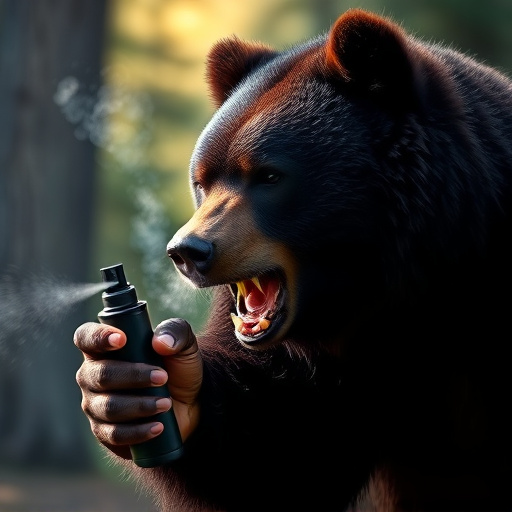Bear spray, equipped with capsaicin, is a powerful tool for deterring black bears in their natural habitat. To ensure safety and effectiveness, users must understand wind direction safety tips: aim for the bear's face and eyes from 20-30 feet away, avoiding winds that could blow spray back. Positioning yourself with your back towards potential bear paths and scanning for signs enhance protection during encounters. After spraying, protect your senses, stay calm, and slowly back away while implementing risk reduction strategies like noise hiking and staying clear of high bear activity areas.
In regions inhabited by black bears, knowing how to defend yourself during encounters is crucial. One popular tool for bear safety is bear spray—a potent deterrent that can protect against aggressive bears. This article explores the effectiveness of bear spray, focusing on its composition and wind direction as key factors in successful defense. We also provide essential safety tips for usage and discuss additional measures to enhance your bear encounter safety beyond just spray.
- Understanding Bear Spray: Its Composition and Effectiveness
- Assessing Wind Direction for Optimal Protection
- Safety Tips for Proper Bear Spray Use
- Enhancing Bear Encounter Safety: Beyond Just Spray
Understanding Bear Spray: Its Composition and Effectiveness
Bear spray is a specialized defense mechanism designed to deter and repel black bears when faced with an encounter in their natural habitat. Its primary active ingredient is capsaicin, derived from chili peppers, which causes a burning sensation when inhaled by the bear. This irritant affects the bear’s sensory systems, temporarily blinding and disorienting it, providing you with valuable time to retreat or seek shelter.
When using bear spray, understanding wind direction safety tips is crucial. Aim for the bear’s face and eyes, spraying from a safe distance of 20-30 feet. Ensure the wind is not blowing directly towards you or towards nearby people or pets, as this could result in accidental exposure to the spray. Proper usage can significantly enhance your safety during encounters with these powerful animals, especially when navigating through their habitat where surprises are common.
Assessing Wind Direction for Optimal Protection
When considering defense against black bears, understanding bear spray’s effectiveness is key, and one often overlooked factor is wind direction. Knowing how the wind is blowing can significantly impact the safety tips for using bear spray. Aiming directly into the wind may result in the spray dispersing too quickly or not reaching the bear effectively.
For optimal protection, it’s recommended to apply bear spray into the wind. This ensures that the irritants remain concentrated and adhere to the bear’s face and fur, causing it to retreat. Always assess the wind direction before spraying—if possible, position yourself with the back of the bear as your windward side, allowing you a better chance at maximizing the spray’s reach and impact.
Safety Tips for Proper Bear Spray Use
When using bear spray, understanding the wind direction is crucial for its effectiveness and your safety. Always scan the area for any signs of a bear’s presence before deploying the spray. Ensure you’re facing away from the potential bear’s path to avoid blowing the spray directly back towards you or other bystanders.
Remember, bear spray is designed to create a barrier of capsaicin, temporarily distracting and disorienting the bear. For best results, aim for the bear’s face and eyes. Keep in mind that wind conditions can change quickly, so be prepared to adjust your position and keep a safe distance from the spray mist to avoid any potential irritation or inhalation hazards.
Enhancing Bear Encounter Safety: Beyond Just Spray
When it comes to enhancing bear encounter safety, relying solely on bear spray isn’t enough. While it’s an effective deterrent, understanding the wind direction and knowing some safety tips can significantly improve your outcome. Always remember the 3 Rs: Reduce, Avoid, and Escape. Reduce the risk by making noise as you hike to deter bears from approaching unexpectedly. Avoid areas with known bear activity during peak seasons. If a bear does approach, escape calmly and quickly while facing away from it, ensuring the bear spray is ready for use.
Bearing in mind the wind direction is crucial when using bear spray. Aim for the bear’s face and eyes, blowing into the wind to ensure maximum effectiveness. Protecting your eyes and respiratory system is paramount after spraying, as bears can still attack if the spray doesn’t immediately deter them. Stay calm, back away slowly, and evaluate the situation before proceeding further.
Bear encounters can be unpredictable, but arming yourself with knowledge and the right tools, like bear spray, significantly improves safety in the wild. Understanding the composition and effectiveness of bear spray ensures its optimal use during encounters. Assessing wind direction is a crucial step to maximize protection from the spray’s range and impact. Following safety tips for proper application enhances your chances of deterring an aggressive bear. Beyond just using spray, fostering overall bear encounter safety involves understanding their behavior and habitat, which can prevent many potential conflicts. By combining these strategies, outdoor enthusiasts can confidently navigate bear country while minimizing risks.
